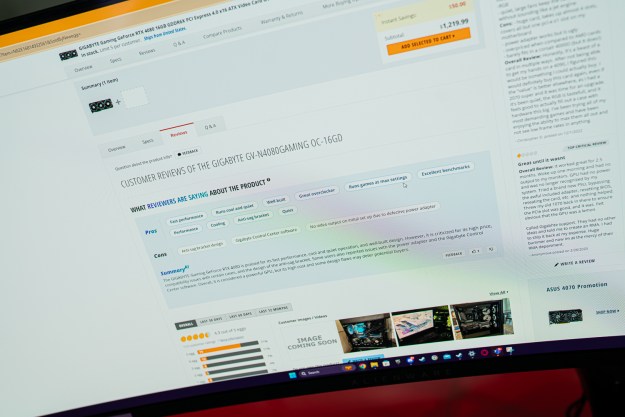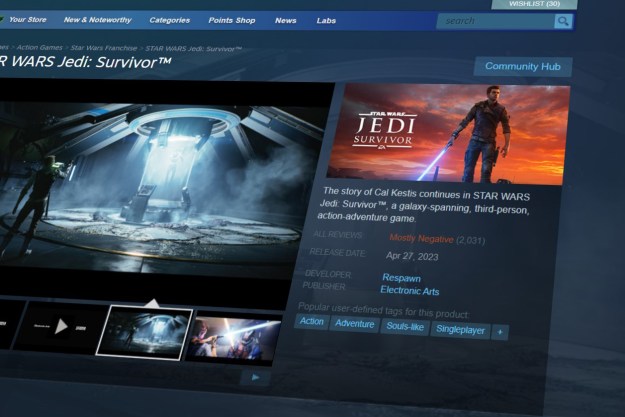“The Gateway FPD2485W is a first-class monitor all around.”
- Excellent image quality; innovative controls; low price
- Large bevel; one-year warranty
Summary
We’ve seen a recent surge in 24” LCD monitors over the last few months. All the major players have weighed in with their single-DVI-saturated behemoths. Gateway has shocked the market with the first high-quality 24” screen priced under $700. No coupons, waiting for sales, or deal site acrobats. The FPD2485W suffers from one fatal flaw, though: consumer perception. Is the FPD2485W priced so low that consumers will doubt the quality? Is this a case of “you get what you pay for”? We are happy to say that the FPD2485W is a first-rate product all around, and we hope to assuage any fears of cheap build quality or missing features.
Features and Design
The FPD2485W specs are impressive on their own. 1920 x 1200 resolution, 1080p support (with HDCP), 1000:1 contrast ratio, 450 cd/m2 brightness, 6 ms response time, and a built-in, four-port USB 2.0 hub. Keep in mind that most people will only need to know the above specs to make a purchasing decision. These specs match or surpass those of the competition. The contrast resolution is good enough for watching darkly-lit video scenes, giving good color saturation. The 6 ms response time means no ghosting or blurring during fast-paced gaming or video.
One important feature for power users is the inclusion of HDCP, an encryption method used to secure high-resolution, next-generation media formats. Both Blu-Ray and HD-DVD require HDCP in order to allow full 1080p playback. At publication time, studios have said that they will not degrade the high-definition signal without HDCP, but the option is always there, and you can bet that once high-definition pirating takes off, the feature will become enabled by default. It is also worth mentioning that the FPD2485W uses a Faroudja DCDi chip for video enhancement.
The FPD2485W has every necessary video connection. Along the back, you’ll find analog VGA, digital DVI, two component inputs, composite, and S-video. The only missing port is an HDMI input, which we expect to see on every monitor this size. The built-in USB 2.0 hub proves useful for removable flash drives, speakers, and webcams. There is also a power connector for the optional speaker bar that snaps into place below the monitor. The speaker bar uses standard stereo and mic connectors and draws power from the FPD2485W. We would have liked to see an optional USB connector to the speaker bar, since it seems like a more streamlined setup.
The TDX speaker bar spans the bottom surface of the monitor and clips into place without the need for any tools. There are the aforementioned standard stereo and mic connectors, two headphones jacks, one mic input, and aux RCA input connectors. The small, but capable, 8 watt speakers have hardware 3D enhancement and are decent for the low price. The speakers will mute when headphones are inserted. The controls located at the center of the bar are all capacitive touch sensitive, meaning there are no moving parts, and the surface is continuous with the casing. These controls include Input, Mode, Power, Mute, and 3D on/off. Since this review is geared toward the monitor itself, rather than this optional add-on, there’s not much else to say about the TDX sound bar. It is attractive, convenient, and is a decent option for everyday multimedia needs.
Audio Controls on the TDX Soundbar
We loved the design of the controls on the monitor. If you have looked at the product images, you’re probably asking, “What controls?” All control buttons are hidden along the right side bevel, with only a small divot in the casing to signify the location of the power button. Once accessible, the buttons glow a soft blue. The menu system is a pure joy to use. Though we do like the tactile feedback of pressing a button, the tradeoff for aesthetics is acceptable — we’d rather have a nice-looking display than ugly buttons we will use a handful of times. The button LEDs can be dimmed for nighttime use. Navigating the menus is simple and is accompanied by audio feedback. Each button press comes with a nice banjo pluck sound, presumably to make up for the lack of tactile feedback. In an office, this could be extremely annoying, but thankfully Gateway has added an option to disable it (or boost the volume if you can’t get enough of that banjo lovin’!).
The touch-sensitive controls light-up when in use
The Picture-In-Picture abilities are very customizable. PIP can display from any source. The size, position, and transparency level can be easily adjusted. Also, the brightness, contrast, hue, and saturation can be tweaked.
The monitor’s configuration screen has several presets that can be independently adjusted. These profiles include, Movie, Game, Pictures, Web, Warm, Cool, and a User customized profile. Each has its own color and contrast parameters. The monitor can be rotated 90 degrees clockwise on its base, and the height of the base can be adjusted, as can the tilt. The one missing dimension is left and right rotation. Also, the power supply for the monitor is built into the casing, which means no unsightly power brick on the floor.
Testing and Use
We used the FPD2485W with a desktop PC sporting an Nvidia GeForce 7950 GX2 over DVI and a laptop with a built-in ATI Radeon Mobility X1400 over VGA. The VGA connection showed some extremely limited blurring and had less accurate colors than the DVI input, but the difference between the two was surprisingly minimal.
Text quality was absolutely beautiful using either input. Being able to view two full pages in Microsoft Word at high quality from a laptop is an awe-inspiring experience. The FPD2485W is so bright that some might find it slightly fatiguing to view text over a long period of time. We recommend changing one of the profiles to a slightly dimmer setting to relieve eye strain. For static picture quality, the contrast ratio really shines. Dim pictures and darker scenes had clearly visible details. Video playback was excellent overall, and there no blurring through the DVI and VGA connections, with some artifacts over VGA when using WinDVD 8. We found that the once our eyes got used to the high contrast ratio, artifacts for web videos and pixelation was more noticeable. Again, this is not a problem with the monitor. We liken the issues we have experienced to buying our first high-quality set of headphones — the issues are from the low-quality source material that has been deemed acceptable by most people.
We also tested Battlefield 2142 with the FPD2485W. Even though EA does not support widescreen monitors, we used the “+ widescreen 1920 x 1200” switch on the shortcut and got acceptable results. There was no noticeable ghosting or motion blurring, and the level of detail was exceptional. All in all, the FPD2485W does an excellent job of showing off everything this LCD panel can do. Keep in mind that most manufacturers use the same actual panels with their own circuit boards and casing, and the important thing to note is that Gateway is able to run with the best of them when it comes to the FPD2485W.
We placed the FPD2485W next to the Dell 2405 FPW (previous generation 24” LCD monitor), and the difference was striking. The current generation Dell monitor costs almost $100 more, but comes with a 3-year warranty. Gateway offers a 1-year warranty standard, with a 3-year warranty optional for $30 (as of the time of publication).
Image Courtesy of Gateway
Conclusion
The Gateway FPD2485W is a first-class monitor all around. The picture quality is excellent, the controls are intuitive and attractive, and the only missing connection is the lack of an HDMI input. The optional speaker bar is an ideal solution for desks where this 24” monster eats available space meant for speakers. The analog VGA quality is also worth noting, making the FPD2485W an ideal second monitor for laptops with graphics chips capable of pushing the pixels. In anycase, if you are shopping for a new PC monitor, consider your searching over – this is the one to get.
Pros:
• Excellent image quality
• Innovative controls
• Low price
Cons:
• Large bevel
• One-year warranty
Editors' Recommendations
- 9 best processors for PC gaming: tested and reviewed
- 10 best gaming monitors of 2024: tested and reviewed
- The 18 best VPN services for 2024, reviewed by experts
- 7 best headsets for PC gaming: tested and reviewed
- Amazon expands use of generative AI to summarize product reviews







